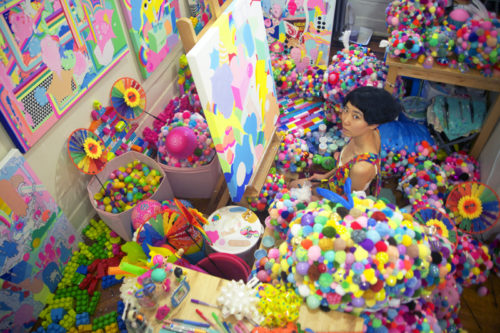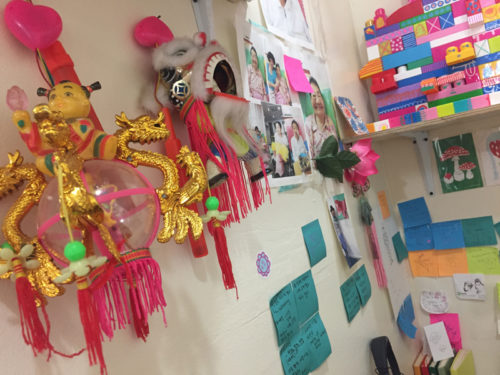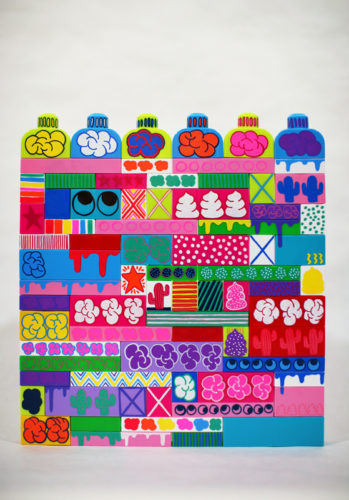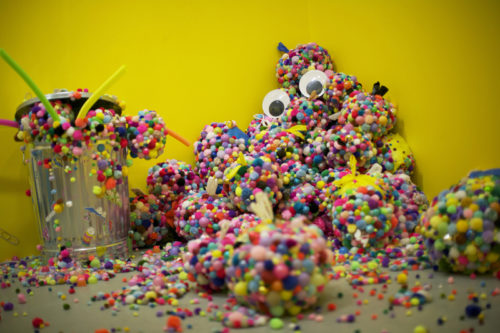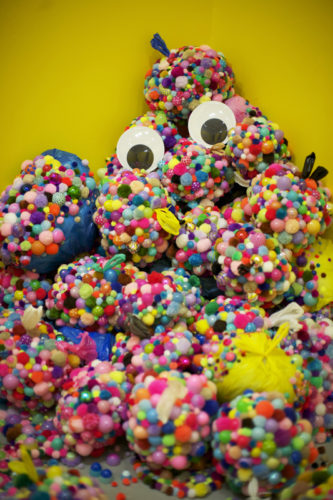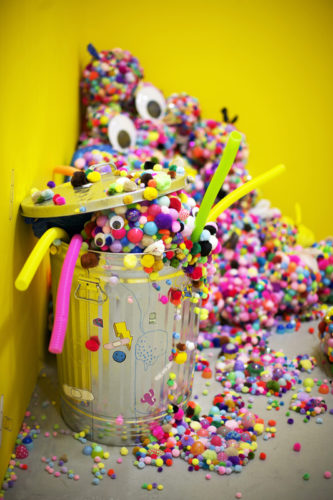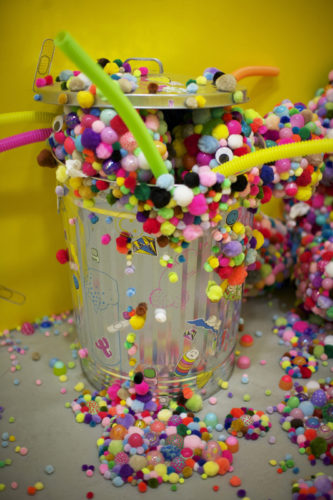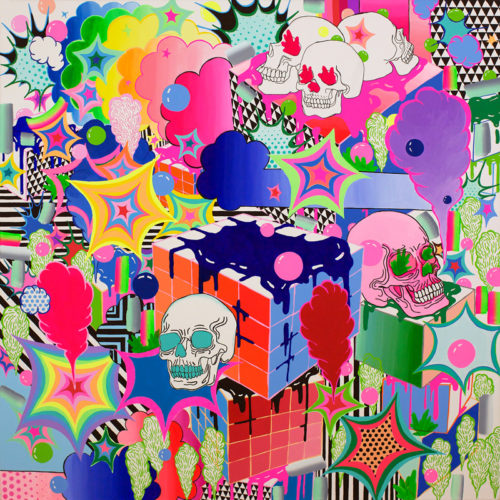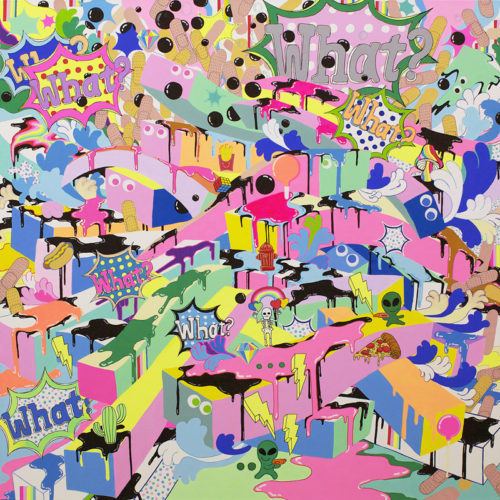Born in South Korea, Adehla excelled in art longer than she can remember. Her parents encouraged her up until a point, but as she came of age, she was strongly encouraged to find a “decent” job. After attending art school, Adehla went on to earn a degree in Art Therapy and worked briefly at the hospital, which she found mildly stimulating for its psychological value. But eventually, Adehla was nearly torn to pieces by her own boredom with the life she was entrenched in. Overwhelmed by expectations of her parents and community, she escaped to America where she felt “happy and free” like never before.
Her art took on new dimensions as she explored America’s hyper-materialist culture, pursuing an MFA at the School of Visual Arts in New York City and ravaging stores like Party City. Her eyes bulged at resplendent displays of toys and plastic and “stuff” like she had never seen before in houses, stores and later – on the street once it was discarded into huge black bags of menacing trash. Her work began to explode with color and texture. Coming from a family of Buddhists, locking her eyes for the very first time with plastic Easter eggs in all shades of neon pink, orange, pastels and shimmering pearlescent hues inspired a restless curiosity in Adehla that fueled her long days and nights making art. She stockpiled plastic Easter eggs in her studio, eventually to build large-scale installations that would interplay with her wondrously luscious acrylic paintings on canvas.
Prior to coming to the states, her work had been engrossed in what Adehla described as “really serious stuff.” Reproductive rights factored in amongst other historically situated gender inequalities. Back in Korea, “[Abortion] is illegal, but if you tell the doctor he will write down that you were raped and give you one anyway. The reality is right now people need abortion, so that’s what the doctors do. It’s the women who have to feel guilty about that.” Coming from a staunchly patriarchal culture where “Men control women,” Adehla’s sophomore work while living in Korea was necessitated by its politics.
“There’s definitely more freedom here than Korea, but still – the sexism – and then there is being Asian.” Adehla explains that she never had to really think about race before moving to the States, where she is now doubly marginalized as a Korean and a woman. “Since Trump it’s been more on my mind,” says Adehla. “I am always aware of my difference.”
“My grandmother is my spiritual God. She was a medium. She was a healer.” Adehla points to some kitschy faux gold Chinese talismans hanging beside photos of her Grandmother, their hot pink tendrils trailing down the white wall hungrily. “This was the feeling of my Grandmother’s room growing up. When I was young I was really afraid of her. She always had this intense presence. Over time she became my favorite person in the world. More than my mom. She is female, but I never really felt like she was female in a way.” Adehla went on to explain that her Grandmother was always too strong, independent and powerful to fit into Korea’s rigid gender roles.
During one of her group crits at SVA a student said to Adehla “this looks like a medium’s room,” which triggered a flood of memories of her Grandmother’s house. The dangling oddities that made up the room’s glittering décor and brightly illustrated charts of multiform bodies and organ systems her Grandmother used to heal the community. Adehla never thought about it until then, but so often these bumpy, organic shapes (reminiscent of her Grandmother’s many colorful charts and diagrams) reoccur in her work.
“My Mom never told me Grandma was a medium. She would always say ‘There is a guest coming for Grandma; you have to leave the room’ when someone came for healing.” It wasn’t until much later, into Adehla’s adolescence, that she discovered what her Grandmother was up to—and that it was considered “Dark.”
According to Mina Cheon in Shamanism + Cyberspace, “Dark” is merely the tip of the iceberg when it comes to societal stigma associated with being female and shaman in Korea, what essentially amounts to the lowliest of low social standing. “South Koreans both celebrate and revile shamans,” writes Cheon. Forgetting that shamanism was once the living culture of Korea – the officiral religion – today’s Korean shamanism is little more than a spectacular tourist attraction. After the government banned shamanic medical healing after the civil war, amidst Korea’s modernization and Westernification shamanism as medicine is still practiced discretely behind closed doors. Korean female shamans are positioned as “spiritually superior and socially inferior;” reservoirs of the curse and blessing called “excess chi,” found, of course, in the womb. Cheon’s work explores how shamanism went from being the central cult of the state to the cult of socially marginalized peoples.
Shamanism within Korean is now so degraded that the shamans themselves do not choose the path. Shamanism chooses Korean female shamans beginning with a chaotic and frenzied “spiritual illness.” It is an illness that causes great distress, to no avail of medical treatments, and after passing through the underworld of ghostly visions and hallucinations, under the care of an elder shaman, the young woman becomes a shaman in exchange. Curiously, writes Cheon, it’s typically a lower-class, young Korean woman that is spirited away, and this “misfortune” of becoming a shaman means she will have no opportunity to raise her social status through marriage or otherwise.1
Although Adehla is glad her path today is called Art (she doesn’t want to be a real medium), for many reasons she resonates deeply with memories of her Grandma’s wise ways. Adehla recalls vividly a period when she, too, fell ill and suffered for nearly a year from terrible nightmares. Rather than uncovering that she was meant to be a medium like Grandma, she discovered that Grandma could help her. “Every time I slept with my Grandmother I never had these nightmares. She was like a living God.”
Adehla doesn’t want her race and gender to affect her work, although those issues occupied much of our nearly two-hour dialogue together. Adehla recalled her Aunt’s struggle with sexism living as one of the few female Buddhist monks, “I see her struggle all the time; Korea sucks in that way.” We talked about marriage and babies: Is it viable for women to be artists and mothers? Who bares the burden of childcare? What about marriage?
“I NEVER thought about getting married growing up. Why would I want to become a servant of my husband’s family?” said Adehla. Currently married to her best friend Tony, an American painter she met at SVA, she said that marriage was something her parents somewhat tried to force her into. Having a single daughter that is older brings shame to a good Korean family. “My parents are very traditional; marriage is something you have to do. When I was getting married, I made one deal – I’m not going to have kids!” According to Adehla the situation in Korea is getting so bad that women’s resistance to having babies (and serving the subsequent lifetime sentence of caretaking and household chores) was causing a concerning dip in the population.
Our conversation slithered back and forth through the precious maze of maternal sexuality and women’s work; our angsty queries rushing into elide mystically with Grandma’s magical dominion, somewhere beyond space and time, her hidden-away household oasis of healing felt fully revived by Adehla’s charged recollections. Not to mention that her studio and its throngs of interweaving forms, which felt like a candy-dappled faerie glen, was the perfect evolution of the lineage she described. “My Grandmother was not a regular woman in Korea, not typical. She was doing what she needed to do in her work, not what society asked of her.”
Adehla’s memories of Grandma recall Anna Lowenhaupt Tsing’s2 Feminist anthropological study of Indonesian medium Uma Adang, a female shaman of the Dayak people of the Meratus Mountains. Tsing’s study of Uma Adang illustrates transcultural interconnections between gender, ethnicity and political marginality relative to Adehla’s family story. Within the psycho-spiritual frameworks of the community, neither Meratus women’s sexuality nor their spirituality meet religious standards. Female shamans challenge gender conventions in order to perform at all, fighting for access to a realm that is already marked as “Exotic/Other” by government and religious officials who closely adhere to the nationally recognized Muslim faith.
In Indonesia as in South Korea, shamanism is not religion, but continually reinforced by the dominant narrative as a “glittering attraction” commercialized for historical value in a marketplace where ethnicity is a product. Tsing writes passionately about Uma Adang’s “committed alienation,” and identifies her refusal to eat rice as the major factor. Meratus mountain people construct elaborate spiritual cosmologies corresponding to their elegant rice-field rituals. As rice is a staple food central both symbolically (and practically) to Meratus livelihood, Adang’s positioning of herself outside the realm of rice’s consumption relieves her of the women’s work associated with it – planting, weeding, harvesting, threshing, pounding, sun-drying, cooking and serving rice.
By side-stepping the very time-consuming and “identity-creating” activities associating rice with Meratus women, Uma draws on a freedom that Tsing explains “allows her to expand her imaginative frameworks.”
Adehla’s choice to establish her creative practice far away from obligations to family, friends and relatives back home in Korea likewise chimes in as a form of self-preserving personal freedom. Her recent installation at Dress Shop Gallery in Bushwick offers her take on what it means to be an American-style material girl. In one thundering crescendo of rainbows, Lee carefully arranged huge mounds of fuzzy pom-poms in the likeness of trash heaps. Some spill forth out of shiny silver trash cans and others emerge as frothing, interstellar monsters with eyes. The lyricism evident in her approach to matter carries through thoroughly, so much that we almost feel like we’ve opened that door unto the otherworld.
Inspired by the humongous piles of trash Adehla walks by on her daily commute, she wonders, What’s inside the shiny black bags anyway? Adehla muses, “There could be anything inside, chopped up bodies…we don’t know.” It’s not a common sight in Korea, where the devastating bell toll of throwaway culture hasn’t taken hold—as here in the West. Although neither her nor her work is direct about the current environmental crisis associated with the waste, she feels there are likely spirits lurking in the miles of curbside debris. Grandma always taught, “There is more than meets the eye. There is a greater spiritual aspect in everything.”
- Shamanism + Cyberspace by Mina Cheon New York: Atropos Press, 2009
- In the Realm of the Diamond Queen Anna Lowenhaupt Tsing, New Jersey: Princeton University Press, 1993
